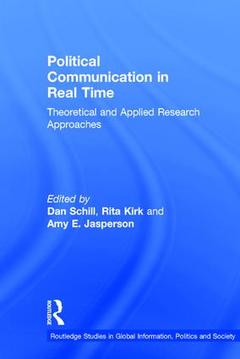Political Communication in Real Time Theoretical and Applied Research Approaches Routledge Studies in Global Information, Politics and Society Series
Coordonnateurs : Schill Dan, Kirk Rita, Jasperson Amy E.

Much has been made of the speed and constancy of modern politics. Whether watching cable news, retweeting political posts, or receiving news alerts on our phones, political communication now happens continuously and in real time. Traditional research methods often do not capture this dynamic environment. Early studies that guided the study of political communication took place at a time when transistors and FM radio, television, and widely distributed films technologically changed the way people gained information and developed knowledge of the world around them. Now, the environment has transformed again through digital innovations.
This book provides one of the first systematic assessment of real-time methods used to study the new digital media environment. It features twelve chapters?authored by leading researchers in the field?using continuous or real time response methods to study political communication in various forms. Moreover, the authors explain how viewer attitudes can be measured over time, message effects can be pin-pointed down to the second of impact, behaviors can be tracked and analyzed unobtrusively, and respondents can naturally respond on their smartphone, tablet, or even console gaming system. Leading practitioners in the field working for CNN, Microsoft, and Twitter show how the approach is being innovatively used in the field.
Political Communication in Real Time is a welcome addition to the growing field of interest in "big data" and continuous response research. This volume will appeal to scholars and practitioners in political science and communication studies wishing to gain new insights into the strengths and limitations of this approach. Political communication is a continuous process, so theories, applications, and cognitive models of such communication require continuous measures and methods.
Part I: Real Time Response Techniques, Approaches, and Insights
Chapter 1: The History, Reliability, Validity, and Utility of Real Time Response
Dan Schill
Chapter 2: Collecting, Interpreting, and Analyzing Continuous Response Data
Jennifer Burton, Jan Gollins, and Danielle Walls
Chapter 3: Strategic Insights: The News Value of Real Time Response Measurements
Rita Kirk
Chapter 4: Social Media and the Rise of the Connected Voter
Sean Evins
Part II: Real Time Effects: Measuring Political Message Effects by the Second
Chapter 5: High-Frequency Polling with Non-Representative Data
Andrew Gelman, Sharad Goel, David Rothschild, and Wei Wang
Chapter 6: Moment-to-Moment Responses to Race-Based Messages in Political Campaign Advertisements
Stephen Maynard Caliendo, Charlton D. McIlwain, and Elizabeth Dudash-Buskirk
Chapter 7: Measuring Effects of Candidates on Voters in Germany: A methodological comparison between Real-Time-Response Measurement and Facial Coding
Simon Ottler, Reza Mousa-Kazemi, and René Resch
Chapter 8: Scalable Multidimensional Response Measurement using a Mobile Platform Philip Resnik, Amber E. Boydstun, Rebecca A. Glazier, and Matthew T. Pietryka
Part III: Partisanship and Polarization: Real Time Selective Information Processing
Chapter 9: Polarization in Less than Thirty Seconds: Continuous Monitoring of Voter Response to Campaign Advertising
Shanto Iyengar, Simon Jackman, and Kyu Hahn
Chapter 10: Polarization in the 2012 Presidential Debates: A Moment-to-Moment, Dynamic Analysis of Audience Reactions in Ohio and Florida
Amy E. Jasperson, Jan Gollins, and Danielle Walls
Chapter 11: How Attacks and Defenses Resonate with Viewers’ Political Attitudes in Televised Debates: An Empirical Test of the Resonance Model of Campaign Effects
Marko Bachl
Chapter 12: Moments of Partisan Divergence in Presidential Debates: Indicators of Verbal and Nonverbal Influence
Shawn R. Hughes and Erik P. Bucy
Dan Schill is Associate Professor in the School of Communication Studies and Affiliate Faculty in Political Science at James Madison University. His research is focused on advocacy, political communication, technology, and the mass media.
Rita Kirk is Professor and Director of the Maguire Center for Ethics and Public Responsibility at Southern Methodist University. Her research focuses on campaign communication concentrating on emergent technologies, the development of public arguments, and hate speech.
Amy E. Jasperson is Associate Professor and Chair of the Department of Political Science at Rhodes College. Her research focuses on media framing and its resonance with citizens, communication during crises, campaign advertising strategies, and gender and media.
Date de parution : 10-2016
15.2x22.9 cm
Date de parution : 10-2016
15.2x22.9 cm
Thème de Political Communication in Real Time :
Mots-clés :
Political Communication; Media & Politics; Political Campaign Processes; Public Opinion; Research Methods; Dan Schill; Rita Kirk; Amy E; Jasperson; Real-‐Time Response Measurement in the Social Sciences; CNN; Microsoft; Twitter; Delta Modelling Group; Big data; Smart Phone; Real Time Responses (RTR); Presidential Debates; Televised Debates; Vice Versa; Continuous Response Data; Continuous Response Measurement; Digital Trace Data; Real Time Reaction; RTR; Party Identification; Parliament II; Voter Intent; Media Rating Data; Message Functions; Magid Associates; Obama Vote Share; CRM Data; Party Id; Candidate Evaluations; Random Effect Variances; Dial Testing; Feeling Thermometer Score; Uncommon Situations; Negative Ads; Exit Poll



